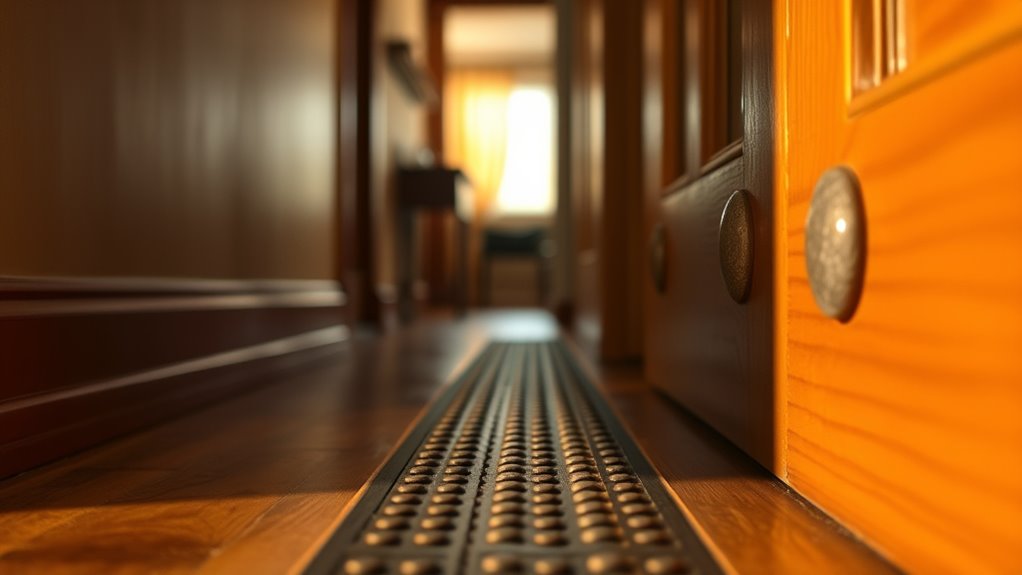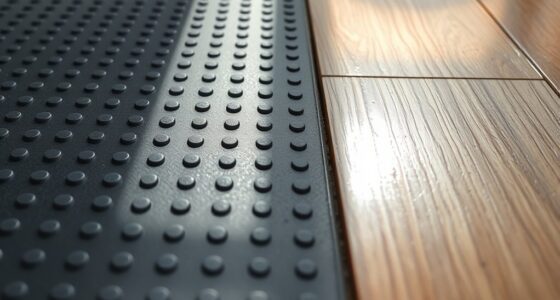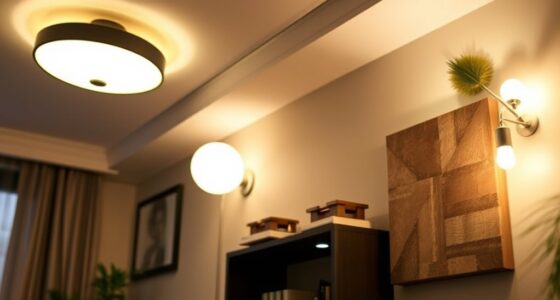Tactile wayfinding at home involves using textured surfaces and markers to help you navigate easily and safely. You can incorporate varied textures like ridged or rough surfaces to mark different zones or hazards, placed near doorways, switches, or thresholds. Combining tactile cues with contrasting colors enhances clarity, especially for those with visual impairments. Choosing durable, non-slip materials and personalizing markers guarantees safety and comfort. Keep exploring to discover how these textures and markers can make your home more accessible and intuitive.
Key Takeaways
- Use differentiated tactile textures like ridged, smooth, or rough surfaces to distinguish zones and pathways.
- Incorporate raised symbols and patterns near doorways, switches, and key areas for easy tactile identification.
- Position tactile markers consistently at accessible heights to promote predictable navigation.
- Select durable, slip-resistant materials such as textured rubber or reinforced tiles for safety and longevity.
- Combine high-contrast colors with tactile features to enhance visibility and tactile discrimination simultaneously.
Understanding the Benefits of Tactile Cues in Your Home

Tactile cues can considerably enhance your home’s accessibility by providing clear, physical signals that help you navigate spaces more confidently. Modern sensor technology plays a crucial role by detecting your movements and triggering tactile cues, such as textured surfaces or vibrations, at key points. These cues alert you to changes, obstacles, or room entrances, reducing confusion and increasing independence. Additionally, auditory signals are often integrated with sensor systems to reinforce tactile information, offering an extra layer of guidance. This combination ensures you receive both physical and sound-based cues, making navigation intuitive and safe. The use of contrast ratio in visual cues can also improve the clarity of signals in different lighting conditions. By understanding and utilizing these tactile cues, you can create a more accessible environment that promotes confidence, safety, and autonomy in your daily routines.
Choosing the Right Textures for Different Areas
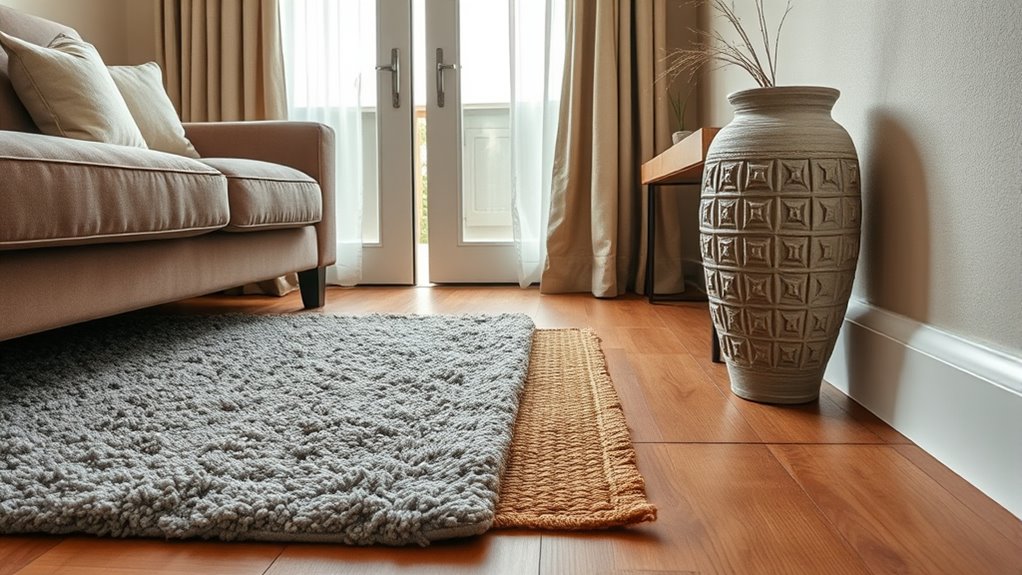
When selecting textures for different areas, consider surface durability and safety to prevent slips or falls. You’ll want to use distinct tactile cues for each zone to help navigation, like softer surfaces in bathrooms and rougher ones in hallways. Also, choose materials that are compatible with your cleaning routines and maintenance needs to keep your home safe and functional. Incorporating quality, durable materials ensures long-lasting performance and ease of upkeep.
Surface Durability and Safety
Choosing the right textures for different areas in your home is essential for ensuring surface durability and safety. You want surfaces that can withstand regular use without showing excessive surface wear, which can compromise both appearance and safety. In high-traffic zones, opt for durable materials like textured rubber or reinforced tiles that resist wear over time. Slip resistance is vital, especially in areas prone to moisture, such as kitchens and bathrooms. Textures with good slip resistance help prevent falls and injuries by providing better grip underfoot. Avoid slick or overly smooth surfaces in these zones. Additionally, selecting appropriate textures that balance durability and slip resistance can help extend the lifespan of your surfaces while maintaining safety. By selecting textures that balance durability and slip resistance, you create a safer environment that remains functional and reliable, supporting tactile wayfinding without sacrificing safety.
Texture Differentiation by Zone
Selecting the right textures for different areas in your home enhances both safety and functionality. By establishing distinct texture zones, you create tactile differentiation that helps you identify spaces through touch alone. For example, use smooth, low-friction textures in hallways to indicate movement paths, while rougher, grippier surfaces can mark entry points or progression zones. Different textures can also signal functional areas, such as a soft mat near the bathroom for comfort or a textured tile in the kitchen to prevent slips. Consistent tactile cues across zones make navigation intuitive and reduce the risk of accidents. Remember, the goal is to choose textures that are distinguishable by touch, durable enough for their environment, and comfortable for everyday use, ensuring your home remains accessible and safe.
Material Compatibility and Maintenance
Ensuring that textures are compatible with your home’s materials and easy to maintain is essential for long-term safety and durability. When selecting tactile markers, consider material compatibility to prevent damage or deterioration over time. For instance, using water-based paints or non-porous finishes can reduce staining and make cleaning easier. material compatibility to prevent damage or deterioration over time. For high-traffic areas like hallways or kitchens, choose textures with low maintenance requirements that resist wear and dirt buildup. Avoid materials prone to staining, cracking, or requiring frequent sealing. In contrast, softer textures may work well in bedrooms or living spaces, where maintenance is less intensive. Regular cleaning and inspection help preserve tactile markers’ effectiveness. By balancing material compatibility with practical maintenance needs, you guarantee that your tactile wayfinding system remains reliable, safe, and aesthetically pleasing for years to come.
Incorporating Raised Symbols and Markers
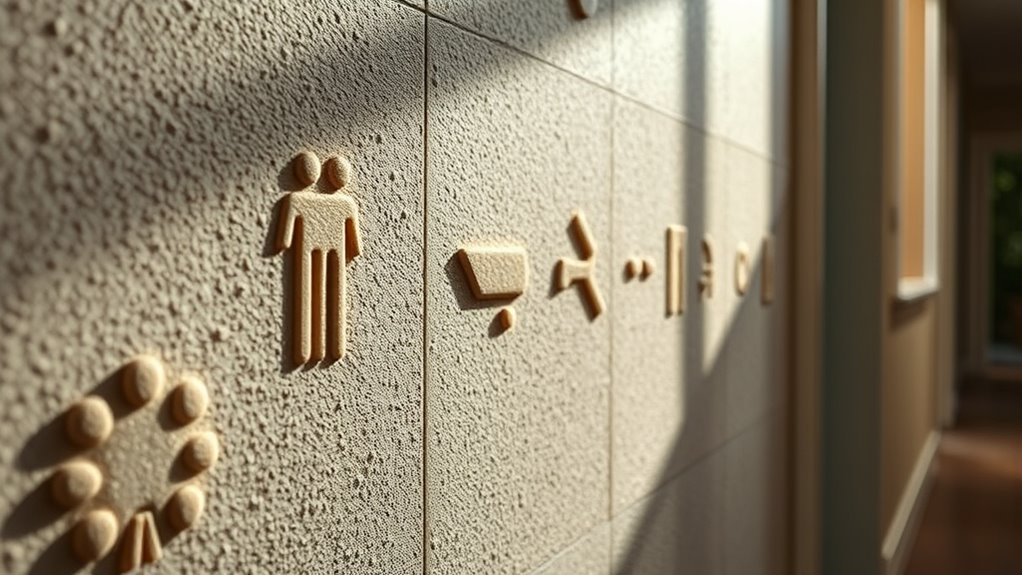
Incorporating raised symbols and markers into your home can substantially enhance tactile wayfinding for visually impaired individuals. Start with careful texture selection to guarantee markers are distinguishable by touch. Choose materials that contrast in texture from surrounding surfaces, such as smooth versus rough or ridged versus flat, to improve recognition. When placing markers, position them consistently near doorways, switches, or important areas, ensuring they’re accessible without obstruction. Proper marker placement helps create a logical system that users can navigate intuitively. Keep in mind that tactile markers should be durable and securely affixed to withstand daily use. Additionally, understanding beneficiary designation rules can prevent costly errors in accessibility modifications. By thoughtfully selecting textures and strategically placing markers, you make your home more accessible and easier to navigate for those relying on touch.
Using Color and Contrast to Enhance Tactile Features
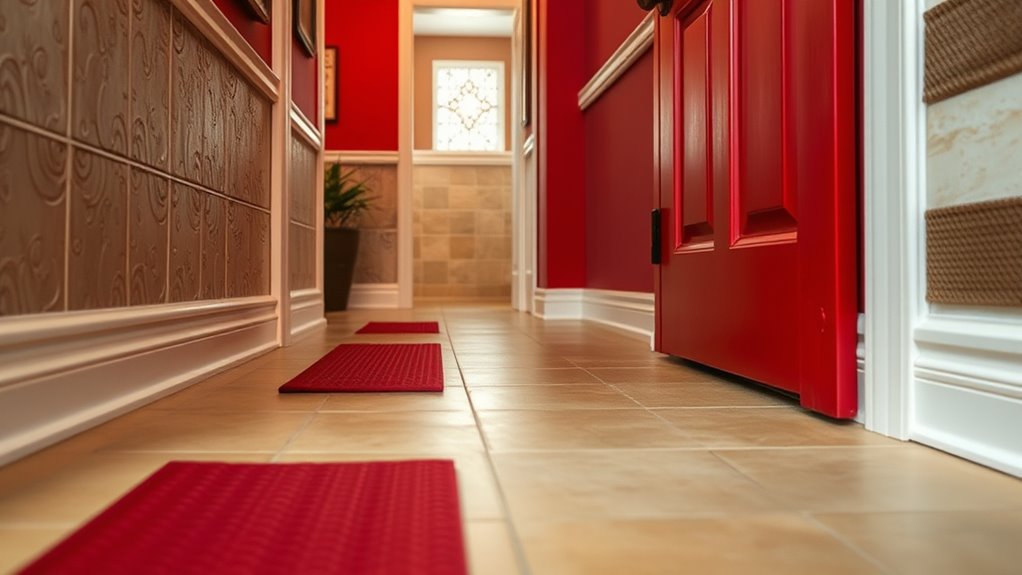
Using color and contrast can make tactile features easier to identify at home. You can improve navigation by choosing color differentiation strategies that highlight key areas, even for those with limited vision. High contrast techniques further guarantee tactile cues stand out, making your environment more accessible and intuitive. Incorporating soulmate angel numbers into your awareness can also foster a sense of connection and reassurance as you navigate your space.
Color Differentiation Strategies
Color and contrast play a crucial role in making tactile features more distinguishable at home. By using effective color coding, you help create clear visual cues that complement tactile markers. Choose distinct colors for different zones or objects to make them easily identifiable, even at a glance. Incorporate strong visual contrast between features and their backgrounds to maximize visibility for those with partial sight. For example, pairing light-colored textures with dark backgrounds or vice versa enhances differentiation. Consistent color schemes across your home ensure familiarity and quick recognition. Remember, the goal is to make tactile features stand out visually without overwhelming the senses. Thoughtful color differentiation supports independent navigation and enhances overall safety at home. Additionally, understanding visual contrast principles can further optimize the effectiveness of your color strategies.
High Contrast Techniques
High contrast techniques can markedly improve the visibility of tactile features at home by making them stand out more clearly. Using bold colors and contrasting shades enhances texture patterns and guides tactile marker placement effectively. For example, pairing dark textures with light backgrounds helps tactile markers and textured surfaces become more distinguishable. Consider the table below for contrasting options:
| Texture Pattern | Contrast Color Pairing |
|---|---|
| Ribbed | White on black |
| Dotted | Yellow on navy |
| Striped | Black on white |
| Raised symbols | Bright red on beige |
These high contrast techniques ensure tactile markers are more noticeable, improving navigation and safety at home. Consistent application across textures and markers creates a cohesive, accessible environment that supports independent movement. Incorporating contrast techniques into your design can significantly enhance overall tactile clarity and ease of use.
Materials and Tools for Creating Tactile Surfaces
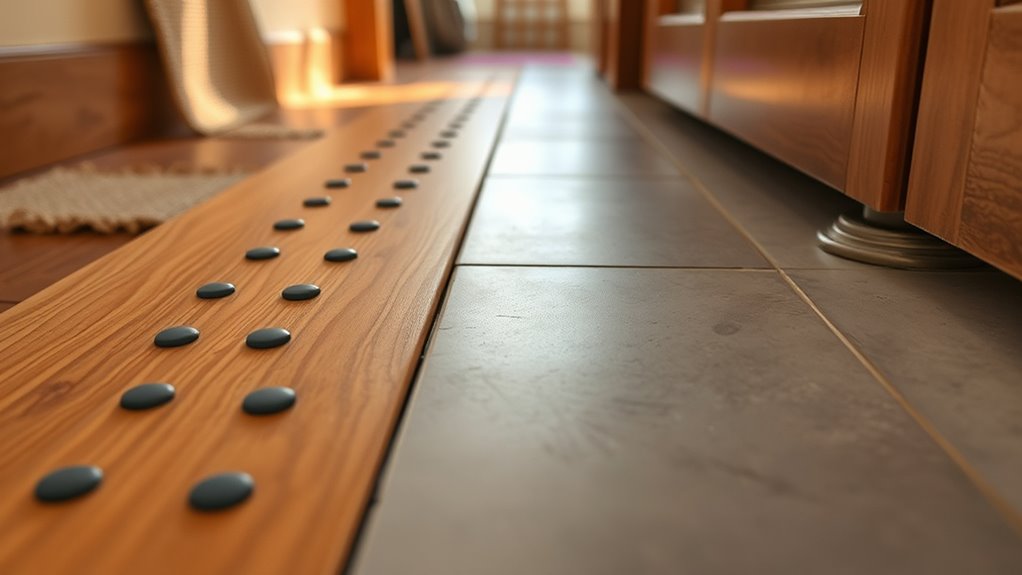
Creating effective tactile surfaces for wayfinding relies on selecting the right materials and tools. Textile overlays are a popular choice because they’re flexible, durable, and easy to customize with different textures and patterns. They can be directly applied to walls, floors, or furniture to provide clear tactile cues. Tactile tiles are another essential material, offering a sturdy, uniform surface that can be embedded with raised symbols or textures for easy recognition. When choosing materials, consider their slip resistance, weather durability, and ease of maintenance. You’ll also need tools like adhesive spreaders, cutting implements, and texture rollers to guarantee precise application and consistent surface quality. Using the right combination of textile overlays and tactile tiles helps create accessible, effective tactile wayfinding surfaces in your home. Additionally, selecting materials that are wear-resistant ensures longevity and sustained effectiveness of the tactile cues over time.
Design Tips for Seamless Integration of Tactile Markers
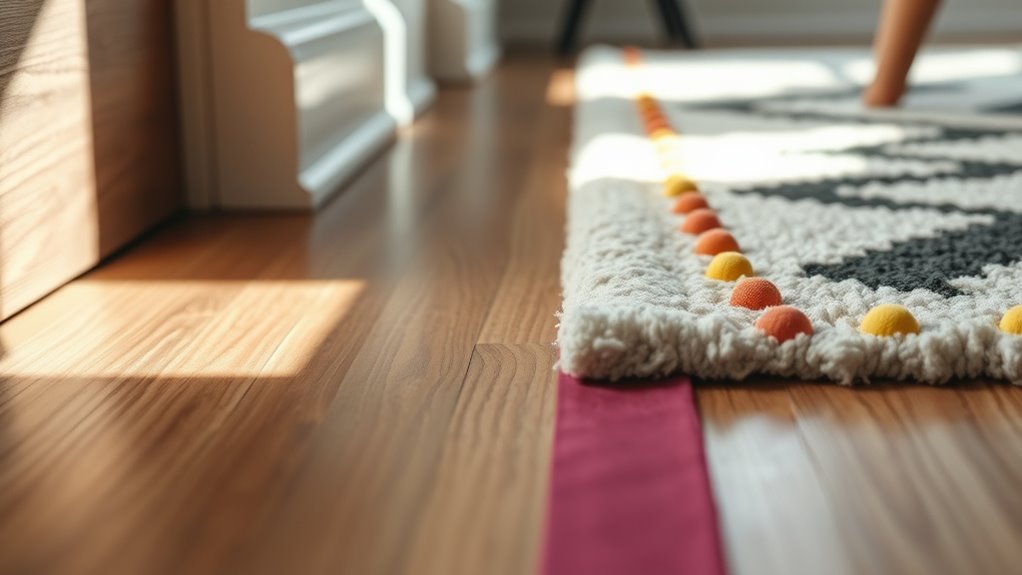
To guarantee tactile markers blend seamlessly into your home environment, careful planning of their placement and design is essential. You should select textures that complement your decor, ensuring they don’t stand out visually but still provide effective haptic feedback. Use tactile art thoughtfully to create visual interest without overwhelming the space, integrating it as part of the overall design. Position markers at consistent heights and locations where they’re easy to find naturally, avoiding clutter or overly conspicuous areas. Keep in mind that tactile cues should be intuitive and unobtrusive, enhancing navigation without disrupting aesthetics. Incorporating a cohesive color palette can help the tactile markers harmonize with your room’s decor and prevent them from appearing out of place. By balancing function and style, you create a harmonious environment where tactile markers feel like a natural extension of your home’s design.
Safety Considerations When Implementing Tactile Cues
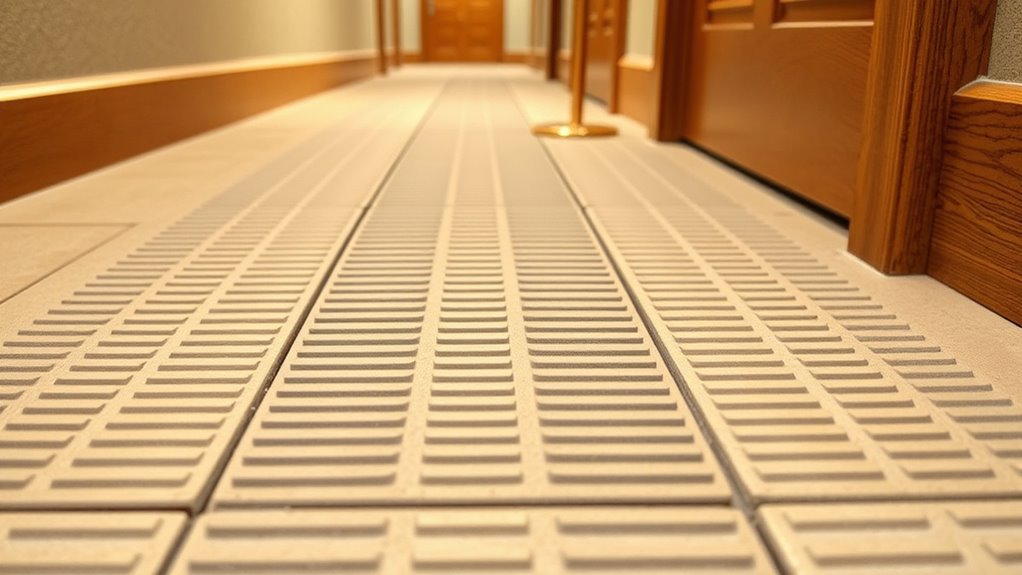
When adding tactile cues at home, you need to prioritize safety by choosing materials that meet safety standards to prevent any health risks. You should also consider the placement carefully to minimize tripping hazards. Addressing these points helps make sure your tactile wayfinding system is both effective and safe to use.
Material Safety Standards
Ensuring material safety standards when implementing tactile cues is essential for protecting users from potential hazards. You should select materials that meet safety regulations to prevent injuries or allergic reactions. Avoid sharp edges, splinters, or rough textures that could cause cuts or discomfort. Check that surfaces are durable and non-toxic, especially since tactile cues are often touched frequently. Properly tested materials help prevent hazards like slipping or deterioration over time. Additionally, confirm that textures are distinguishable and consistent to avoid confusion. Prioritize materials with proven safety records and compliance certifications. By focusing on material safety, you minimize risks and create a reliable environment for tactile wayfinding, ensuring users can navigate confidently without exposure to unnecessary dangers.
Risk of Tripping
Implementing tactile cues can introduce tripping hazards if not carefully planned. You need to guarantee that textured surfaces or markers don’t create a trip hazard or increase slip risk. Poorly placed tactile markers may cause you to stumble or lose balance, especially if they are uneven or too prominent. To minimize this risk, position tactile cues along stable, even surfaces and avoid abrupt height changes. Use non-slip materials and ensure pathways remain clear of clutter. Regularly inspect tactile features for wear or damage that could contribute to a slip risk. Remember, safety isn’t just about marking paths but also about preventing accidents. Thoughtful planning and proper maintenance help ensure tactile cues assist navigation without compromising safety.
Personalizing Your Tactile Wayfinding System
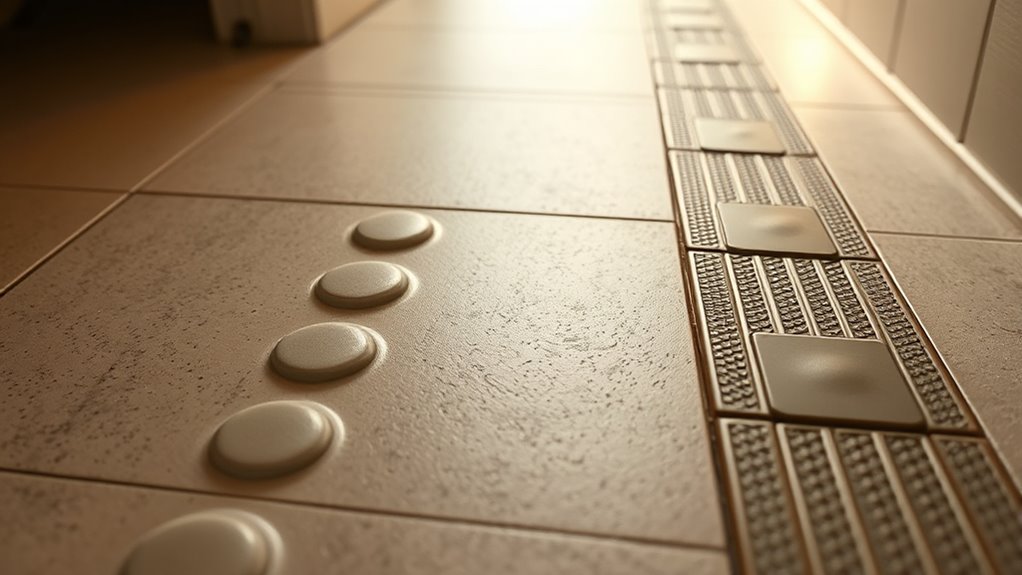
Personalizing your tactile wayfinding system allows it to better suit your specific needs and preferences, making navigation more intuitive and comfortable. By incorporating elements like textures, shapes, and markers that resonate with you, you enhance sensory integration and create a more meaningful environment. Tactile art, such as custom patterns or symbols, can serve as unique cues that reflect your personality or daily routines. To deepen your connection, consider:
Personalize your tactile system with textures and symbols that evoke positive feelings and reflect your routines.
- Choosing textures that evoke positive feelings or memories
- Incorporating symbols meaningful to your daily activities
- Using contrasting tactile markers for better differentiation
These personal touches not only improve usability but also foster a sense of ownership and comfort within your space, making navigation both functional and emotionally satisfying.
Maintaining and Updating Tactile Markers Over Time
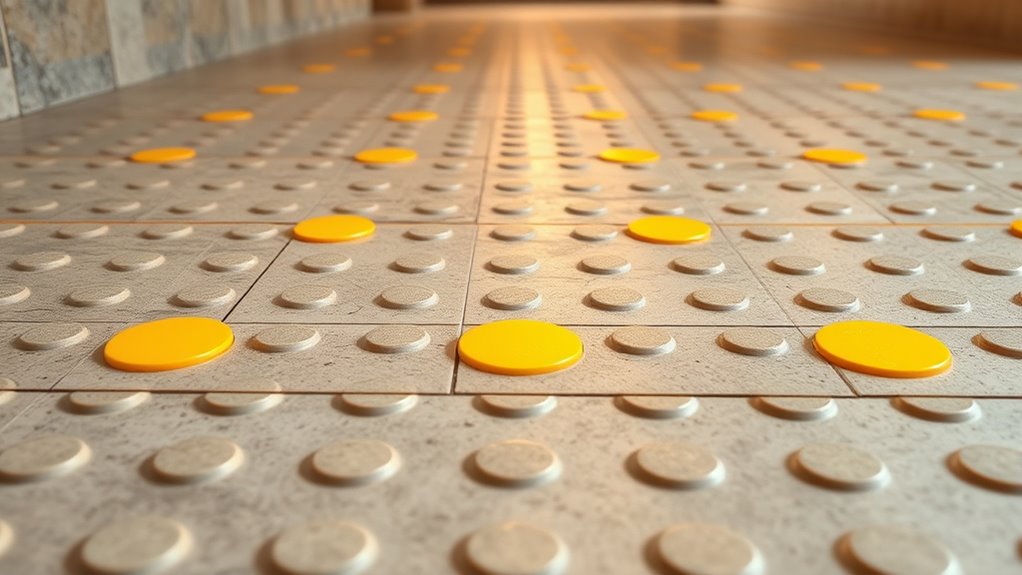
Over time, tactile markers can wear down, become less effective, or lose their distinctiveness, which can make navigation more challenging. To keep your system reliable, establish a regular maintenance schedule. Check markers frequently for signs of damage, fading, or deterioration. When you notice wear or loss of tactile quality, it’s time for marker replacement. Staying vigilant ensures your wayfinding system remains clear and accessible. Updating markers as needed prevents confusion and maintains safety. Keep spare markers on hand so replacements can be quick and easy. Regular maintenance not only prolongs the lifespan of your tactile system but also ensures it continues to serve its purpose effectively. Consistent upkeep is key to maintaining independence and confidence in your home environment.
Resources and Inspiration for Tactile Home Design
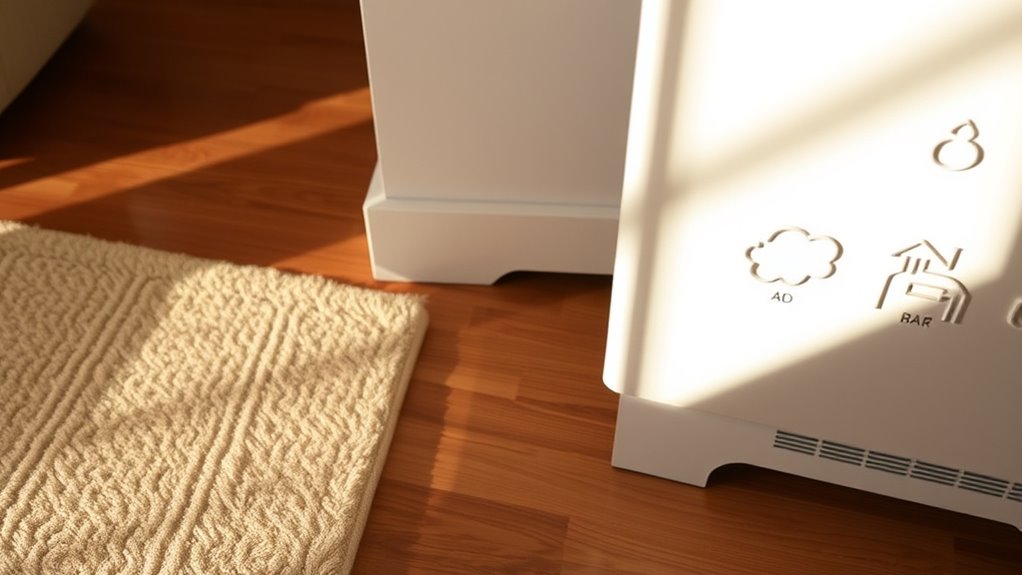
Finding inspiration and resources for tactile home design can transform your space into a safer and more accessible environment. Explore ideas through online communities, specialized catalogs, and local workshops focused on tactile textures and markers. Indoor plants not only add sensory variety with their textures and scents but also serve as natural guides within your home. Incorporate smart home technology, like voice-activated lighting or tactile switches, to enhance accessibility. To deepen your understanding, consider:
- Connecting with organizations that promote accessible interior design
- Visiting showrooms that showcase tactile materials and textures
- Experimenting with DIY projects to personalize tactile cues
These resources can help you create a space that’s both functional and inviting, tailored to your tactile needs and preferences.
Frequently Asked Questions
How Do Tactile Cues Differ for Children Versus Adults?
You’ll find tactile cues differ for children and adults because they focus on age-appropriate cues aligned with cognitive development. For children, textures are often larger and more distinct, making them easier to recognize and remember. Adults benefit from subtle, detailed markers that support their more advanced understanding. By tailoring tactile cues to age, you guarantee effective wayfinding, helping everyone navigate your home confidently and safely.
Can Tactile Markers Be Used Outdoors or in Wet Areas?
Did you know 85% of tactile markers are designed for indoor use? Yes, tactile markers can be used outdoors or in wet areas, but weather resistance and material durability are key. Choose markers made from waterproof, UV-resistant materials like silicone or treated plastics to withstand the elements. Properly selected tactile markers guarantee reliable wayfinding, even in challenging weather conditions, helping you navigate safely and confidently outside or in damp environments.
Are There Specific Safety Standards for Tactile Home Surfaces?
Yes, there are safety standards for tactile home surfaces. You should check material regulations to make certain your tactile markers comply with local building codes and safety guidelines. These standards often require hazard warnings to be clearly indicated through specific textures or markers. By following these regulations, you help prevent accidents and ensure that your tactile surfaces provide effective guidance and safety for everyone, especially those with visual impairments.
How Do Tactile Cues Integrate With Smart Home Technology?
Think of tactile cues as the guiding stars in your smart home constellation. You can integrate sensors that detect your movement and preferences, seamlessly connecting tactile markers with your devices. This setup allows for user customization, so your home responds intuitively—lighting, sounds, or vibrations—aligning with your needs. Together, tactile cues and smart technology create a harmonious environment, making navigation safer and more personalized.
What Are Cost-Effective Options for DIY Tactile Wayfinding?
You can create DIY tactile wayfinding solutions using budget-friendly options like textured tape or rubber mats to mark pathways. Use household items such as raised stickers or fabric strips to indicate doorways or hazards. These DIY solutions are easy to install, cost-effective, and customizable to your needs. They help you navigate your home safely without expensive equipment, making tactile wayfinding accessible and practical on a tight budget.
Conclusion
By thoughtfully adding tactile cues to your home, you’ll create a welcoming space that gently guides you with subtle, textured signals. These features can make daily navigation feel more intuitive and comfortable, turning your environment into a quiet partner in independence. With a few simple touches and mindful updates, your home becomes a haven where safety and confidence softly intertwine, inviting you to move through your space with ease and grace.
